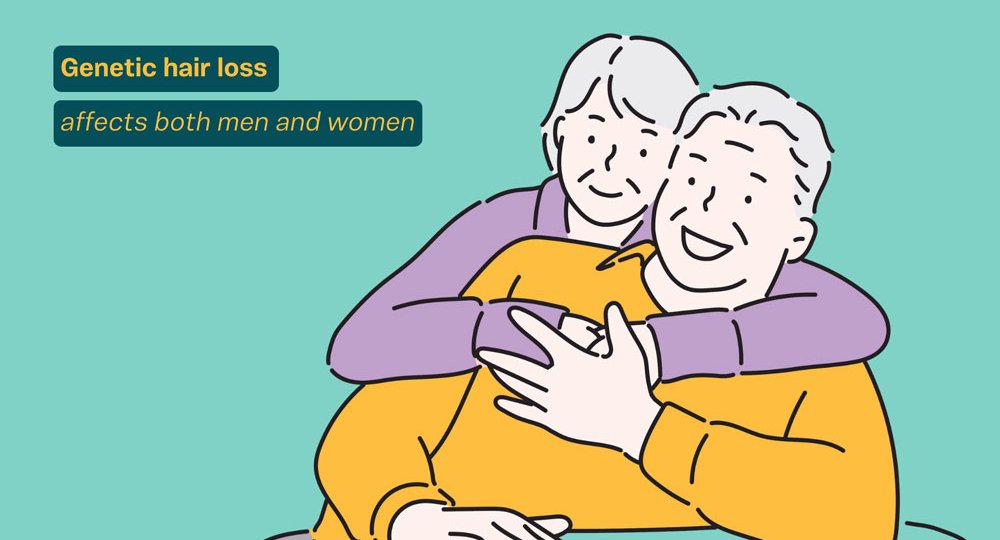Getting in front of female and male pattern baldness
Genetic hair loss isn’t just the most common form of hair loss in men and women. It’s also a type of hair loss we’ve had a lot of success treating at Ashley & Martin. Here’s what we understand about the role of genetics in hair loss and what you can realistically expect from the different treatment options available.
Why are some people more at risk of hair loss?
Genetic hair loss, commonly known as androgenetic alopecia, is the biggest cause of pattern balding. The condition is often linked to the hormone dihydrotestosterone (DHT) which is a byproduct of testosterone. For those who have the genetic susceptibility, DHT can bind to hair follicles, causing them to shrink. This process, known as miniaturisation, shortens the hair’s growth cycle, leading to progressively finer and shorter strands. Eventually the affected follicles close permanently and no longer produce any hairs.

Balding Myths vs. Facts
There are plenty of common misconceptions when it comes to genetic hair loss:
Myth: Only men experience genetic hair loss.
Fact: You might be surprised to know that genetic hair loss is extremely common in women as well as men. In fact, up to 50% of women experience hair loss at some stage. (1.) See more on female pattern baldness here.
Myth: Wearing a hat or helmet will make hair loss worse.
Fact: The notion that wearing a hat will cause hair loss is a common misconception. Genetics play a far more significant role than external factors like hat-wearing. Hats may cause breakage if there is excessive rubbing on the scalp, but they are not a primary cause.
Myth: Hair loss is inherited from the mother’s side.
Fact: Hair loss can come from either side of the family.
Myth: Hair loss skips a generation.
Fact: Hair loss can manifest in any generation. It’s not uncommon for individuals to experience hair loss even if their parents did not. The genetic lottery is complex, and multiple factors contribute to the expression of certain genes related to hair loss.

The best treatments for genetic hair loss
Above all else, the best treatment for genetic hair loss is early intervention. Once your follicles fully close, hair loss becomes permanent and can’t be reversed. To save yourself from bald spots, you should seek treatment as soon as you notice your hair thinning.
Some effective treatments for genetic hair loss include:
Combined / Complete Care treatments:
Without a doubt, the most effective treatments are those that combine a few approaches. Stress, inflammation and nutrient deficiencies could all be contributing to your hair loss on top of your genetic predisposition. As such, these also need to be addressed to give you the best results regrowing your hair.
At Ashley & Martin, we start with a free consultation to explore exactly what’s causing your hair loss. We’ll then recommend a Complete Care treatment plan that is designed to address the specifics of your condition.
DHT Blockers:
For men, oral and topical medications are available to restrict the DHT causing male pattern baldness. These are particularly effective when used in combination with other treatments. For women, androgen blockers may be recommended instead.
Vasodilators:
Other medications for men and women help by increasing the circulation in your scalp. This causes hair follicles to open up, increasing the number of actively growing strands.
Laser hair caps:
Low Lever Laser Therapy (LLLT) devices, such as laser hair caps or helmets are a drug free alternative to regrow hair at home. Laser therapy works in a similar way to vasodilators, increasing blood circulation in the scalp. This opens your hair follicles for thicker, stronger, healthier hair. (2.)
Natural hair loss treatments:
Some natural supplements such as saw palmetto have proven to be beneficial restricting DHT production. (3.)
Make today your turning point
By dispelling myths and embracing the facts, you can make an informed decision on the best hair loss treatment for you. To get to the root cause of your condition and find out what your options are, take advantage of a free hair loss assessment from Ashley & Martin.
References
- RACGP – Female pattern hair loss. Racgp.org.au. Published 2019. https://www1.racgp.org.au/ajgp/2018/july/female-pattern-hair-loss
- National Library of Medicine, “Role of Low-Level Light Therapy (LLLT) in Androgenetic Alopecia” https://www.ncbi.nlm.nih.gov/pmc/articles/PMC8906269/
- National Library of Medicine, “Natural Hair Supplement: Friend or Foe? Saw Palmetto, a Systematic Review in Alopecia” https://pubmed.ncbi.nlm.nih.gov/33313047/
